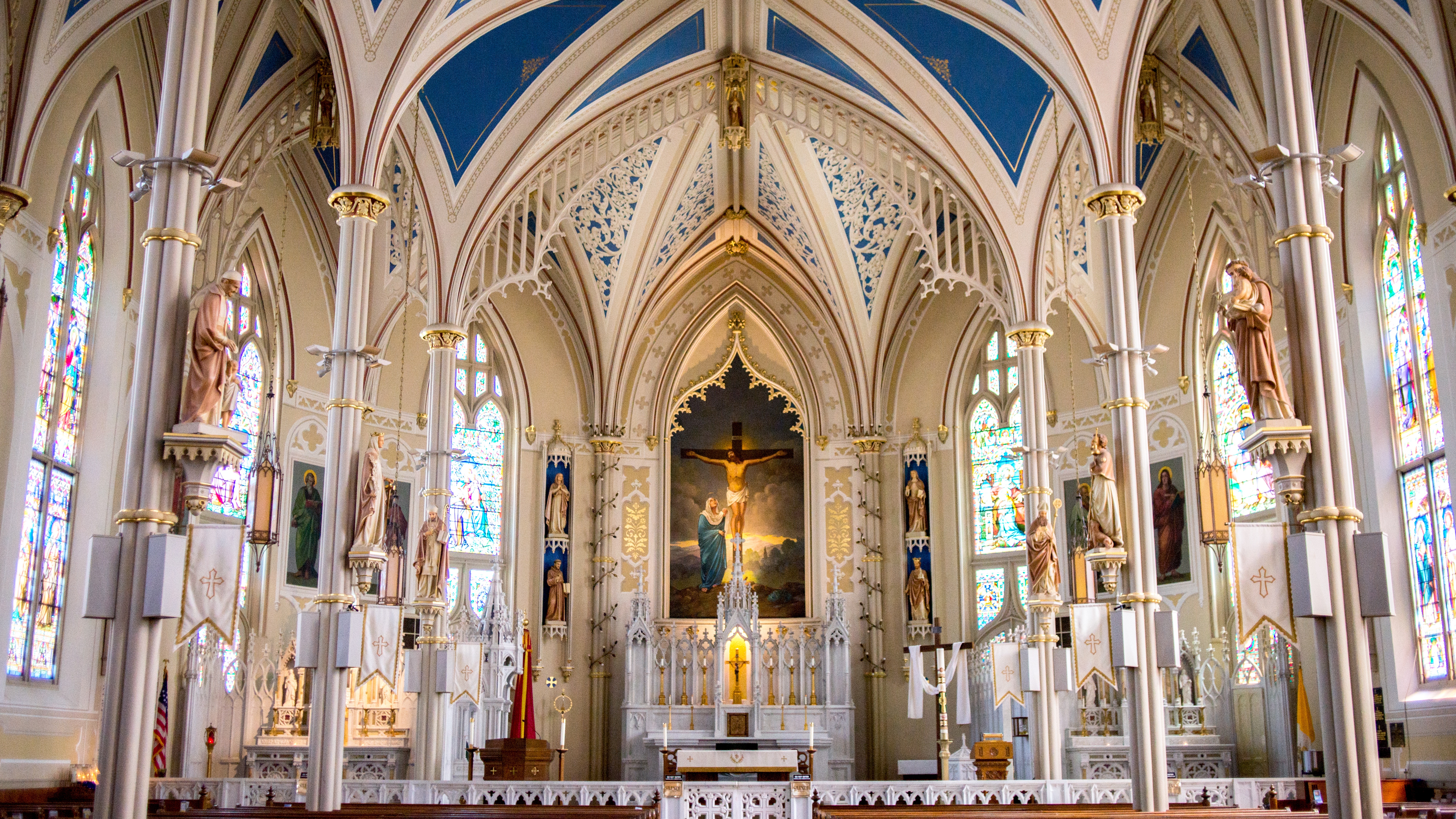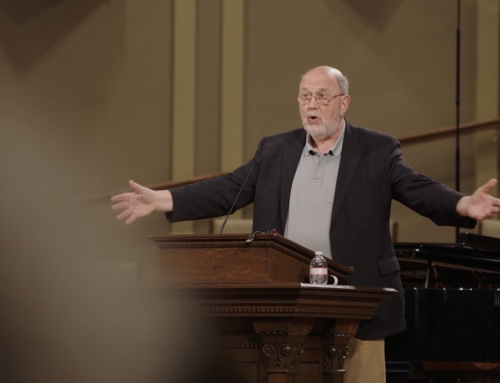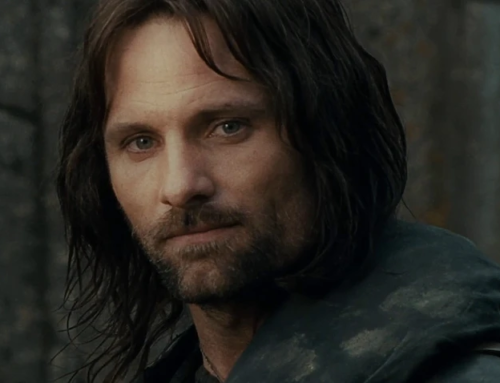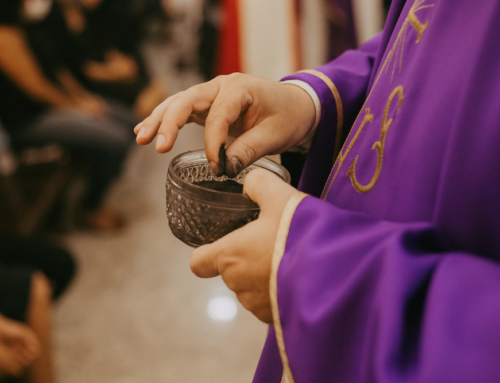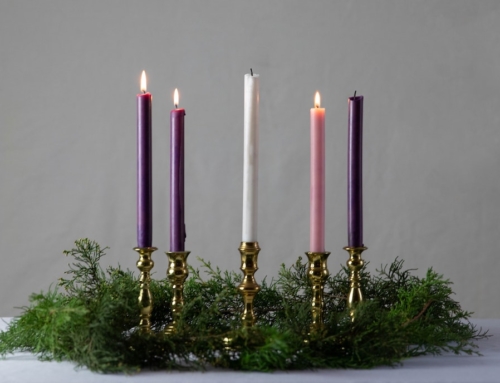John wants us to know that heaven and earth have met.
This theme of heaven meeting earth grows and swells throughout John, through the reference to Jacob’s Ladder at the end of chapter One, into the wedding at Cana in chapter 2 (the wedding symbolizing the coming together of heaven and earth), followed at once by the Temple-scene where Jesus is ‘speaking of the Temple of his body’ and so on.
As with several of John’s themes, not least the Word itself, these are stated emphatically at the start in order that the reader may then hold them in mind while, so to speak, watching the action unfold: this, we are to understand, is what is really going on.
When, on Easter morning, Mary sees the two angels in the tomb, they are sitting one at the head and the other at the feet of the slab where Jesus’ body had laid—a reflection, as some have pointed out, of the mercy-seat at the heart of the sanctuary. This is where the living God meets with his people.
In particular, all this is what is going on with the revelation of the divine glory: as we shall see, the ancient Jewish hope for the divine glory was for a renewed temple, as in Ezekiel, to which the glorious presence would return at last.
The second point, closely allied to the themes of new creation and new temple, is the role of humans in God’s image.
The climax of Genesis 1 comes at verses 26–28; if Genesis 1 is the great cosmic temple, then humans are the divine image placed within that temple.
Imagery and Temple Worship
This rules out at a stroke centuries of puzzle as to what aspect of humanity might be supposed to be the divine ‘image.’ That isn’t the point. The picture is vocational (and indeed to see it like that sets in quite a new context all the great questions of sin and salvation, as I have argued elsewhere).
The ‘image’ in a temple is there for a purpose, indeed for a double purpose, so that the worshipers may bring their worship to the image and thus to the god who is ‘imaged’, and so that the power and protection and stewardship of the god may flow out through the image to the world around.
This would be true of any pagan shrine and image, and it is what Genesis is saying about the vocation of human beings within the heaven-and-earth temple we call the cosmos. The god is present in and as the ‘image.’ Psalm 8 picks up this theme and, in later usage, applies it not least to Israel’s king, and perhaps also to the high priest.
And when we read John 1 in this light we see that at more or less the same point in the story – at the climax of the narrative – where Genesis has the creation of humans in God’s image, John has the Word becoming flesh.
Incarnation: Jesus as the Image of God
And the close thematic parallels to this passage in Colossians 1 and Hebrews 1 ought to leave us in no doubt that John wants us to make exactly that connection. Jesus is the true human, the ultimate Image-bearer, the one in and as whom the creator is now present in, with and for his creation.
John emphasizes this most strongly when Jesus stands before Pilate on the Friday, the sixth day of the week, and Pilate declares ecce homo, ‘behold the man.’
John’s narrative is nearly complete at that point, still following through the themes of creation and new creation, Jesus goes to his death with the word tetelestai, ‘it’s finished’, echoing Genesis 2:1–2. The six-day work is done, and on the seventh day God rests, this time in the darkness of the tomb, before the new creation which, as John emphasizes, happens ‘on the first day of the week.’
But if John is writing a new Genesis then verse 14 is also an indication that he is including a new Exodus at the same time.
This brings me to the another point. One of the themes to emerge from recent work on ancient biblical temple-theology is the reading of Genesis and Exodus as a single narrative arc. From early days, and particularly in the second-temple writings, the wilderness tabernacle and then the Jerusalem temple were seen as small working models of the whole creation.
They were not ‘religious’ buildings seen as an escape from the rest of the world, signaling access to a remote divine sphere; they were advance signposts, eschatological pointers, indicating (like Noah’s ark itself) that, despite the vocational failure of the image-bearers, the waters of chaos would not overcome the world.
The calling of Abraham in Genesis 12, with Abraham seen very much as the new Adam, points ahead to the whole Exodus narrative with its climax in the Tabernacle into which the divine glory comes to dwell.
This it seems is the purpose of Israel, Abraham’s family, to be the guardians of the tabernacle, the carriers of the promise that there would be new heavens and new earth. The slavery in Egypt, and then the Exodus, speak volumes about how the people of Israel, themselves part of the Adam-problem, can fulfill this vocation.
The giving of Torah seems in this light to be the preparation for the coming of the Tabernacle and particularly of the divine glory that will dwell in it. All this is vital for John as he unfolds this major theme: that when the Word becomes flesh and ‘tabernacles’ in our midst, we gazed upon his glory, glory like that of the father’s only son, full of grace and truth.
There are multiple echoes here of the Exodus-story in which God reveals to Moses that he is full of hesed and emeth. Even the Johannine theme of Jesus as the Passover Lamb is, I think, subordinate to this point. In Exodus the new working model of creation has its own divine image within it in the person of the High Priest, Aaron himself.
Learn more about what gospel writers like John really meant in our course The Day the Revolution Began.
Latest posts by N.T. Wright (see all)
- Sneak Peek: What to Expect When Prof. Wright Comes to Houston - May 11, 2023
- The Music of New Creation: Holy Week Eucharist Reflections from N.T. Wright - April 14, 2022
- Hope Amid the Broken Signposts - February 17, 2021


